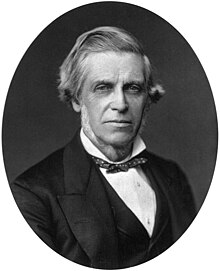William Bowman
Sir William Paget Bowman, 1st Baronet (born July 20, 1816 in Nantwich , Cheshire , † March 29, 1892 in Joldwynds near Dorking ) was a British ophthalmologist, physiologist and anatomist .
Live and act
From 1832 to 1837 he studied medicine at Birmingham Hospital . In 1837 Bowman left Birmingham to pursue his medical training at King's College , London . Here he worked under the physiologist and anatomist Robert Bentley Todd and got a position as a demonstrator at the anatomical museum in London in 1838. At the age of 25, Bowman discovered a membrane on the kidney corpuscle , which is now called Bowman's capsule after him . In 1842 he proved that the glomerula of the kidney corpuscles and the tubules of the kidney form a functional unit. By consistently including microscopy, he was able to elucidate further anatomical structures that also bear his name today: the Bowman glands in the olfactory mucosa and the Bowman membrane ( Membrana limitans anterior ) of the cornea of the eye . The term sarcolemma , which has existed since 1840, comes from Bowmann. In 1847 he discovered the radial fibers of the ciliary muscle .
In collaboration with Todd Bowman prepared the five-volume Physiological Anatomy and Physiology of Man ("Physiological Anatomy and Physiology of Man", 1843-1856) and the reference work " Cyclopaedia of Anatomy and Physiology " (1852).
From 1844 Bowman practiced as an ophthalmologist at the Royal London Ophthalmic Hospital (now Moorfields Eye Hospital ) and from 1846 he worked as a surgeon. Between 1848 and 1856 he taught as a professor of anatomy and physiology at King's College. He then devoted himself entirely to ophthalmology and became the leading “Ophthalmic Surgeon”. In 1880 Bowman founded the Ophthalmological Society (now the Royal College of Ophthalmologists ).
Awards
In 1841 he was elected as a member (" Fellow ") in the Royal Society , which in 1842 awarded him the Royal Medal . In recognition of his services, Queen Victoria bestowed him on January 23, 1884 with the hereditary title of Baronet , of Clifford-street, in the Parish of St. James, Westminster , in the County of Middlesex , and of Joldwynds, in the Parish of Holmbury St. Mary, in the County of Surrey . In 1890 he was elected to the American Academy of Arts and Sciences .
literature
- Reinhard Hildebrand: Rudolf Albert Koelliker and his scientific contacts abroad. In: Würzburg medical history reports. Volume 2, 1984, pp. 101-115; here: p. 103.
Web links
Individual evidence
- ↑ Barbara I. Tshisuaka: Bowmann, Sir William. In: Werner E. Gerabek , Bernhard D. Haage, Gundolf Keil , Wolfgang Wegner (eds.): Enzyklopädie Medizingeschichte. De Gruyter, Berlin / New York 2005, ISBN 3-11-015714-4 , pp. 202 f .; here: p. 202.
- ↑ Barbara I. Tshisuaka: Bowman, Sir William. 2005, p. 202.
- ↑ Horst Kremling : Kidney and Pregnancy. In: Würzburg medical history reports. Volume 9, 1991, pp. 11-16; here: p. 11.
- ↑ Barbara I. Tshisuaka: Bowman, Sir William. 2005, p. 202.
- ^ The London Gazette : 25305, 78 , Jan. 4, 1884.
- ^ Entry on Bowman; Sir; William (1816-1892) in the Archives of the Royal Society , London
| predecessor | title | successor |
|---|---|---|
| New title created | Baronet, of Clifford Street and of Joldwynds 1884-1892 |
William Bowman |
| personal data | |
|---|---|
| SURNAME | Bowman, William |
| ALTERNATIVE NAMES | Bowman, William Paget (full name) |
| BRIEF DESCRIPTION | British ophthalmologist and anatomist |
| DATE OF BIRTH | July 20, 1816 |
| PLACE OF BIRTH | Nantwich |
| DATE OF DEATH | March 29, 1892 |
| Place of death | Joldwynds at Dorking |
